 WTSP Paper: ETRIA TFC2018 WTSP Paper: ETRIA TFC2018 |
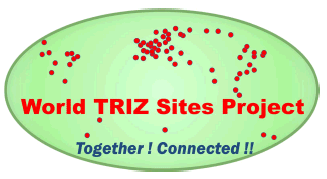


|
World TRIZ Sites Project (WTSP) for Building and Maintaining Catalogs of Global TRIZ Resources |
WTSP Global Co-editors:
Toru Nakagawa (Osaka Gakuin University, Japan), Darrell Mann (Systematic Innovation Network, UK), Michael Orloff (Academy of Instrumental Modern TRIZ, Germany) , Simon Dewulf (AULIVE, Australia) , Simon Litvin (GEN TRIZ, LLC., USA), Valeri Souchkov (ICG Training & Consulting, Netherlands)
|
Presented at TRIZ Future Conference 2018 (TFC2018), held by European TRIZ Association (ETRIA) on Oct. 29-31, 2018 at INSA, Strasbourg, France. |
| Posted: Nov. 11, 2018 |
For going to Japanese pages, press  buttons.
buttons.
 Editor's Note (Toru Nakagawa, Nov. 8, 2018)
Editor's Note (Toru Nakagawa, Nov. 8, 2018)
The World TRIZ Sites Project (WTSP) has been proposed, initiated, prototyped, appealed, organized, reported, etc. through the present Web site "TRIZ Home Page in Japan". Public presentation of WTSP were given at Japan TRIZ Symposium2018 (Sept. 13-14)  for the Japanese audience, and at ETRIA TFC2018 (Oct. 29-31, in Strasbourg) for international audicence.
for the Japanese audience, and at ETRIA TFC2018 (Oct. 29-31, in Strasbourg) for international audicence.
In the present page, the Summary slides (of 8 slides)  and the Presentation slides (17 slides)
and the Presentation slides (17 slides)  are posted before the Full paper (19 pages)
are posted before the Full paper (19 pages)  . I tried to make the preentation slides as compact as possible to fit in the 20 minutes time frame for the presentation including Q&A. The Summary slides are printed on double sides of a sheet and handed out to the participants. I made these slides with a sense of crisis facing with the difficulties: "Many people support the aims of WTSP but very few actually join to work together".
. I tried to make the preentation slides as compact as possible to fit in the 20 minutes time frame for the presentation including Q&A. The Summary slides are printed on double sides of a sheet and handed out to the participants. I made these slides with a sense of crisis facing with the difficulties: "Many people support the aims of WTSP but very few actually join to work together".
The following is my Quick Report of ETRIA TFC2018 to WTSP Members on Nov. 3:
Dear WTSP Members,
On Oct. 29 - 31, TFC2018 was held at Strasbourg with 123 participants successfully.
Nakagawa (with 5 Global Co-editors) gave a presentation on WTSP. The paper is already accessible at TFC2018 Web site, and the presentation slides will be posted in a week in my Web site.
I also had a small booth of WTSP and asked many participants one by one to join the project
and 45 people newly signed in the WTSP Membership Application !!
Thus over 70 persons are now our WTSP team.
But our WTSP project is still very weak, because almost all the Members are saying VERY BUSY and can't spend so much time.
This is natural and we have to work together as effectively as possible under these situations.
In addition, among the 100 TRIZ Leaders whom I have been sending the WTSP invitation/information so far, nearly 60 people have not yet joined WTSP. Because of their big influences on the TRIZ communities in their countries and in the world, their help and collaboration are indispensable for the success of our project. This is especially important in the cases of USA and Russia.
I am going to send the Membership Application Form to the signed-in new Members. After receiving the Forms, I will post the names of the Members in TRIZ Home Page in Japan.
Anyway we are at a new stage of starting the actual work of building WTSP Catalogs in each country.
Let's work Together ! Connected !!
Best wishes, Toru Nakagawa
This report expresses positive expectations and yet difficult situations. We have to overcome the difficulties, Together ! Connected !!
The message of WTSP to you and to all is:
There are many wonderful TRIZ-related Web sites
in your country and in the world !
By building the WTSP Catalogs of them, we can learn a lot easily.
Take a look at Japan WTSP Catalog as an example.   . .
In the WTSP project, let's work Together ! Connected !! |
We are going to set up the goal "Report the Completion of World WTSP Catalog (2019) at ETRIA TFC2019 in October 2019". For this goal, we should organize WTSP teams in every country before the Christmas/New Year vacation".
WTSP is open to everybody. WTSP needs your help and your collaboration. Please read the Slides in this page and join to work together for building the WTSP Catalogs in your countries and in the world !!
 Presentation Slides (Summary Version) PDF (8 slides/ 2 pages)
Presentation Slides (Summary Version) PDF (8 slides/ 2 pages) 
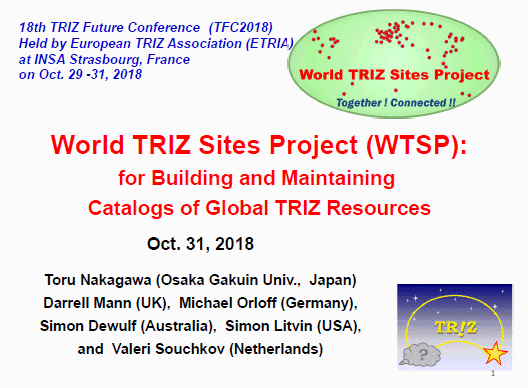
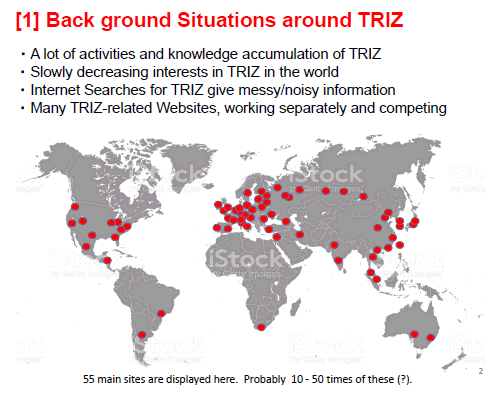
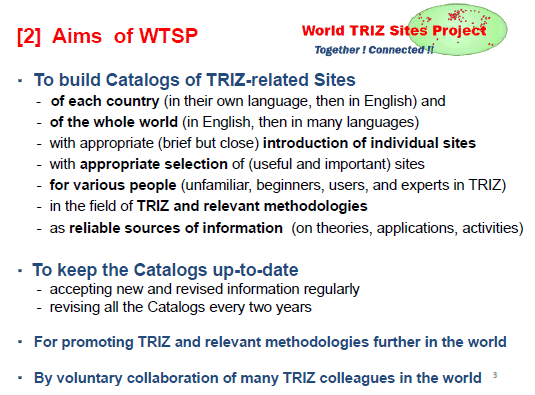
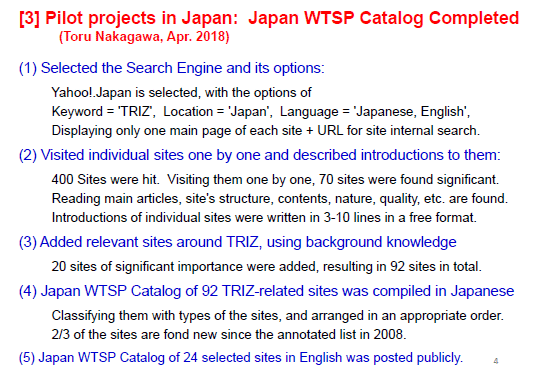
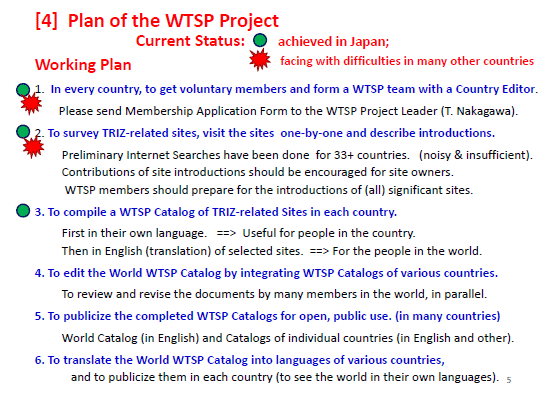
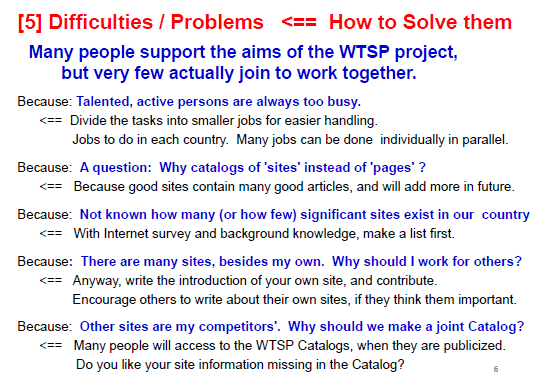
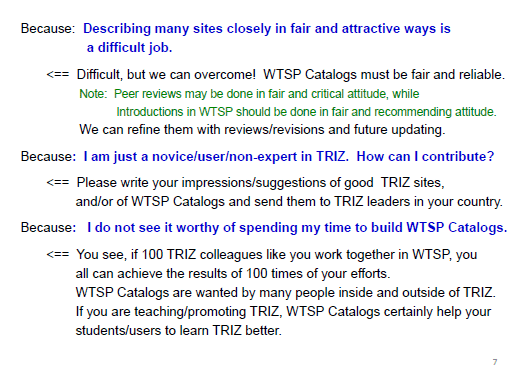
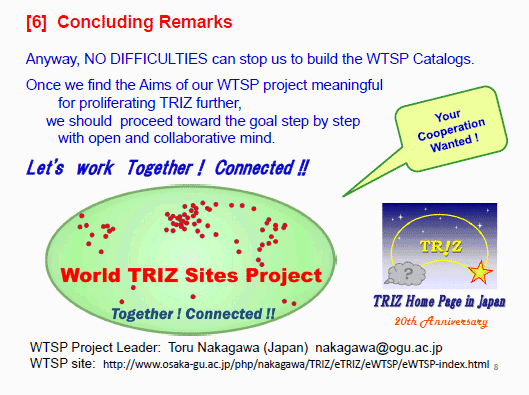
 Presentation Slides (Full Version) PDF (17 slides)
Presentation Slides (Full Version) PDF (17 slides) 
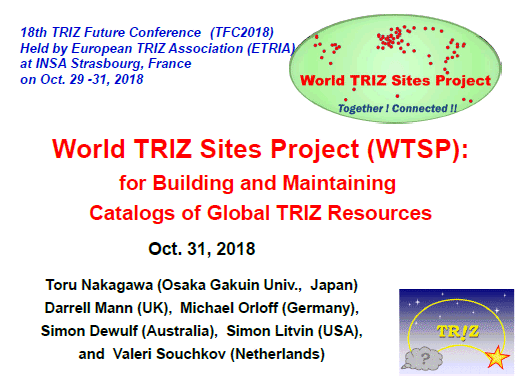
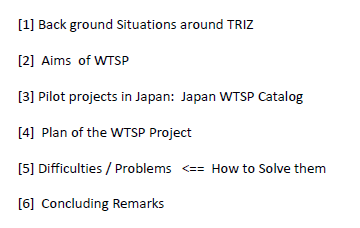
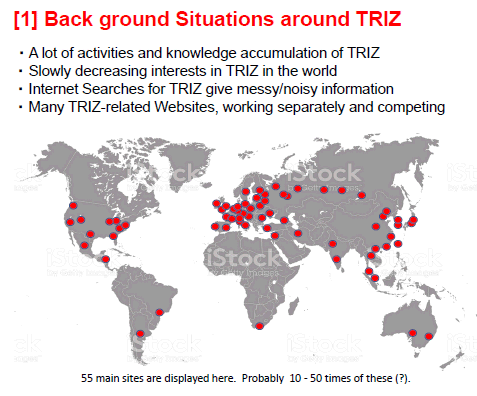
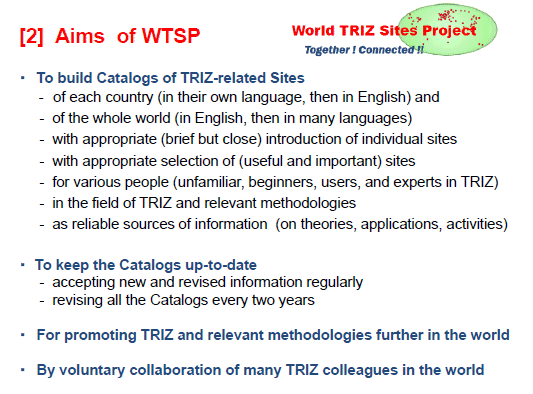
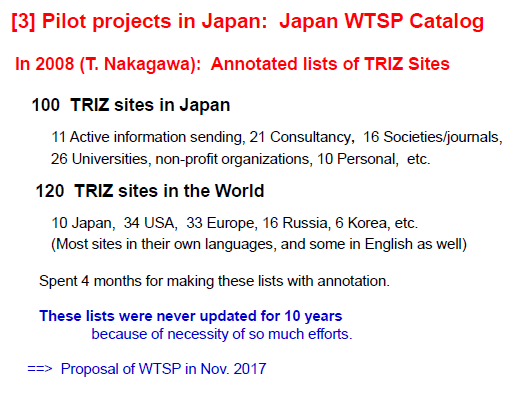
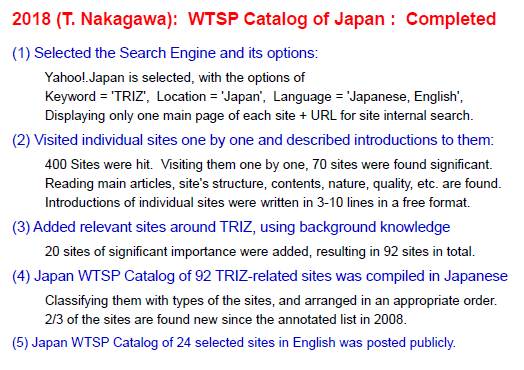
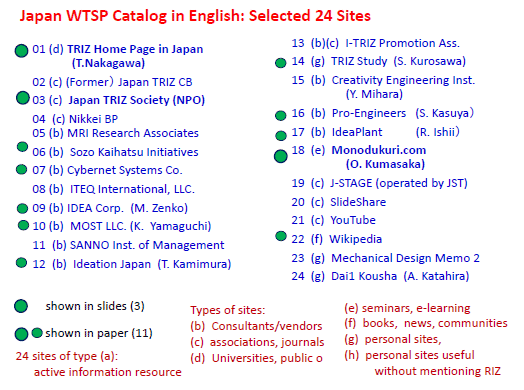
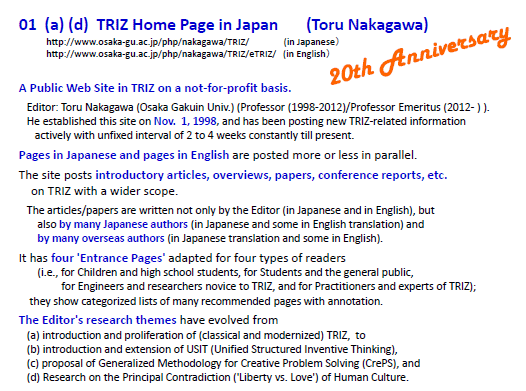
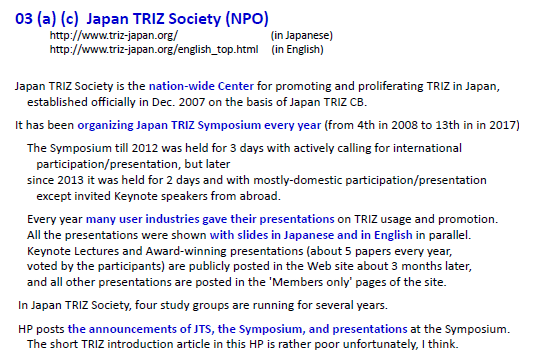
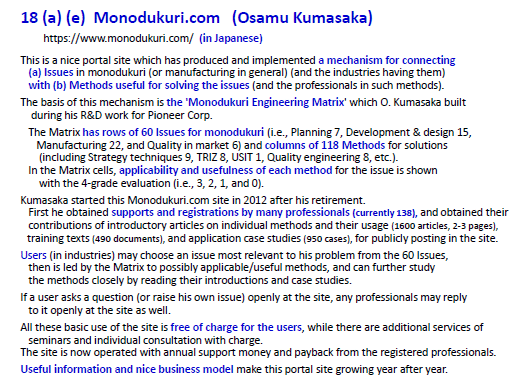
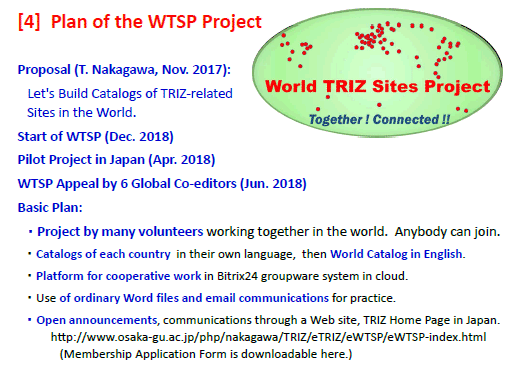
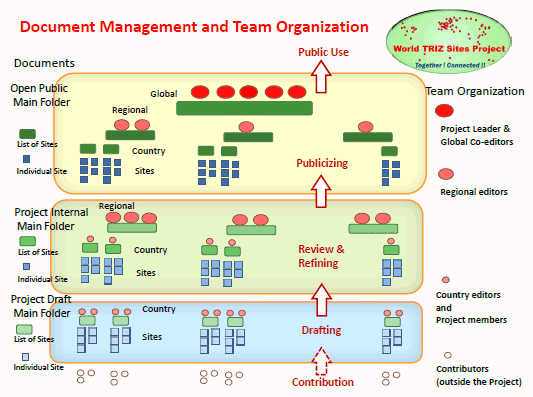
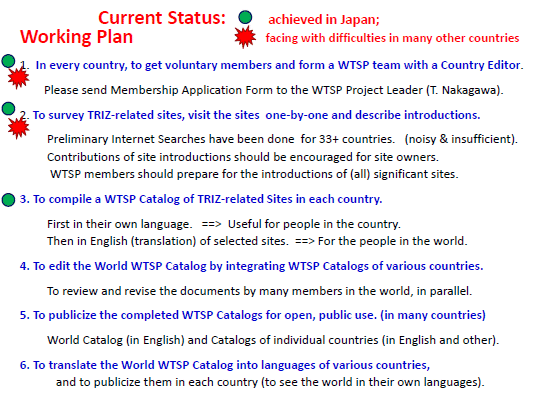
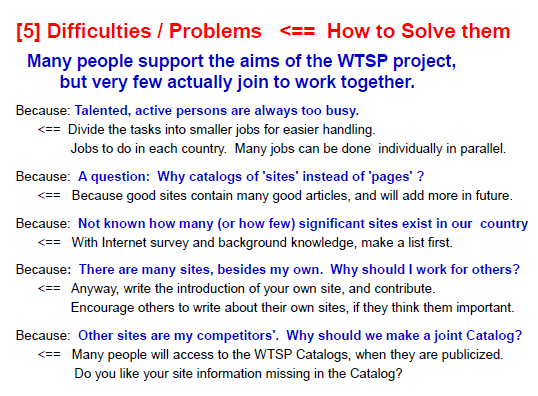
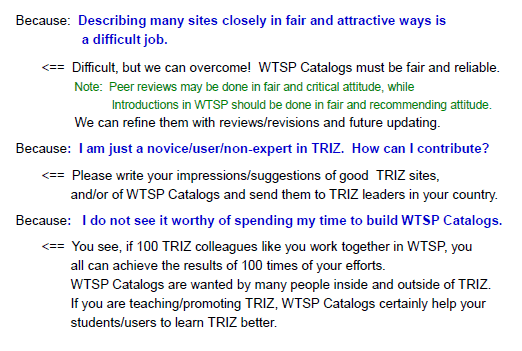
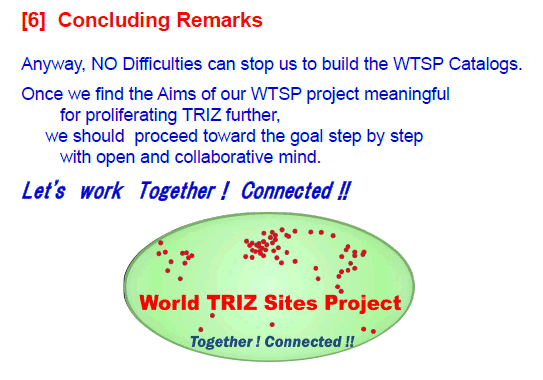
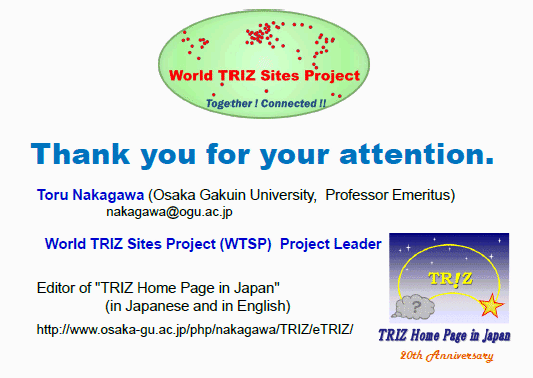
 Full Paper PDF (19 pages)
Full Paper PDF (19 pages) 
World TRIZ Sites Project (WTSP)
for Building and Maintaining Global Catalogs of TRIZ-related Web Sites
Toru Nakagawa1, Darrell Mann2, Michael Orloff3, Simon Dewulf4, Simon Litvin5, and Valeri Souchkov6
1 Osaka Gakuin University, 3-1-13 Eirakudai, Kashiwa, Chiba 277-0086, Japan
2 Systematic Innovation Network, Bideford, UK
3 Academy of Instrumental Modern TRIZ, Berlin, Germany
4 AULIVE, Glen Elgin, Australia
5 GEN TRIZ, LLC., Newton, MA, USA
6 ICG Training & Consulting, Enschede, Netherlands
nakagawa@ogu.ac.jp
Abstract.
For these three decades, TRIZ has been proliferated much across the world beyond ex-USSR to the extent that various activities, achievements, and accumulated knowledge are not viewable easily. We know that many researchers and practitioners are working on TRIZ actively and presenting/posting their activities and results in conferences, journals, Web sites, etc. In typical Internet search on TRIZ, however, a flood of not-so-high quality information actually hides valuable information resources. So we have recently started World TRIZ Sites Project (WTSP). Its initial goal is to build Catalogs of TRIZ-related Web Sites in the World. In various countries good and useful Web sites are operated in their own languages, including English. Thus we should work Together! Connected!! Once we build such catalogs in English, we can share them widely in various language editions. Such information sharing will raise a Global Network of Public Web Sites in TRIZ.
Keywords: World TRIZ Sites Project (WTSP), Global collaboration, TRIZ information resources, Catalog of TRIZ Sites .
Table of Contents:
1. Introduction
2 Basic Plan of World TRIZ Sites Project (WTSP)
3 Model of WTSP Catalog of TRIZ-related Sites in Japan
4. WTSP Activities in the World
5 Concluding Remarks: Further Visions
References
Appendix: Selected 9 Sites in the WTSP Japan Catalog
1. Introduction
For these three decades, TRIZ has been proliferated widely beyond ex-USSR across the world to the extent that various activities, achievements, and accumulated knowledge are not viewable easily. We know that many (global/country-scale) associations, industries, consultants, academic groups, individual persons are making their TRIZ-related works open in their Web sites. However, the more abundant the works and individual sites grow, the more difficult it has become for people to find good and useful works and learn the overall view of TRIZ because of so much noise in the ordinary Internet search.
A solution for releasing such a difficulty is to ‘Build Catalogs of TRIZ-related Sites in the World’ and to keep them up-to-date. Such an approach was actually carried out by one of the present authors, Nakagawa, 10 years ago. He made a page of ‘Extended 120 TRIZ Links (with annotation) in the World’ and posted it in his public Web site “TRIZ Home Page in Japan” [1]. It lists TRIZ sites from 34 countries (or areas), especially containing 10 sites (selected from 100 sites) in Japan. Then he proposed a vision of ‘Global Network of Public Web Sites in TRIZ: A Proposal for Building A Global TRIZ Community’ [2] . Unfortunately, however, the page of World TRIZ Links was not updated for 10 years until now because of necessity of so much efforts (cf. 4 full months were necessary for the preparation of [1] in 2008), and public Web sites have been seldom established in various countries. Figure 1 shows the locations of current 55 principal Web sites in the world known and selected arbitrarily by Nakagawa.
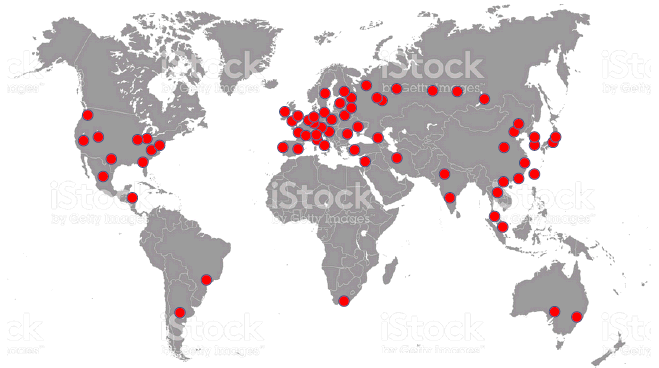
Fig. 1 55 principal Web sites in the world known and selected arbitrarily by Nakagawa.
In November 2017, Nakagawa proposed a project to ‘Build Catalogs of TRIZ-related Sites in the World’, i.e. a complete update of [1], by voluntary cooperation of many TRIZ colleagues in the world. He sent the proposal to about 100 TRIZ leaders of 33 countries, and received much supportive feedbacks from many of them. After a quick preparation, the project started in December 2017 as ‘World TRIZ Sites Project (WTSP)’ [3, 4].
2 Basic Plan of World TRIZ Sites Project (WTSP) [4]
2.1 Aims
-
To build Catalogs of introducing/linking TRIZ-related Web sites in the World.
-
To make visible the TRIZ-related activities, results, and accumulated knowledge in the world
-
To connect the TRIZ-related Web sites in the world together for active information sharing.
-
To work voluntarily and together for developing and proliferating TRIZ and relevant methodologies in the whole world.
-
To make active and cooperative communities in TRIZ and relevant methodologies in the world.
-
To serve for developing and applying TRIZ-related methodologies for solving various problems in the world creatively and innovatively.
-
To contribute to industries, society, culture, etc. in the world.
The Symbol Mark of WTSP (Fig. 2) shows these aims clearly
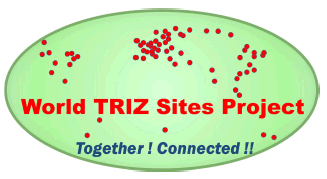
Fig. 2 Symbol Mark of World TRIZ Sites Project (WTSP)
2.2 Goals of Outputs
-
To describe (to introduce) individual Web sites (and similar media) in TRIZ and relevant methodologies in the world.
-
To make Catalogs of such Web sites, in each country, in each Region, and in the whole world.
-
To make Catalogs of such Web sites also in a way categorized with the methodologies and the fields, across the world.
-
The documents are to be written in English finally, but initially in various national languages (as well as in English) in each country, and also the final English editions (of especially the Global Catalog) are to be translated into different national languages for wider dissemination.
-
The output documents are to be openly and widely publicized and shared in the world.
-
The output documents are to be updated regularly (e.g., every 2 years) for reflecting emerging activities, results, and knowledge accumulation.
2.3 Documentation process
Our plan of building and publicizing the documents of the TRIZ-related Sites Catalogs is schematically illustrated in Figure 3. The documents are hierarchically structured, in the bottom-up manner, such as descriptions of individual Web sites, Catalogs of them in each country, Catalogs of them in each region, and finally a Global Catalog. The documents are to be stored and managed consistently in a groupware documentation system which allows collaborative work by many WTSP members in the world. The documents are stored in 3 different main folders according to their stage of refinement with appropriate access control.
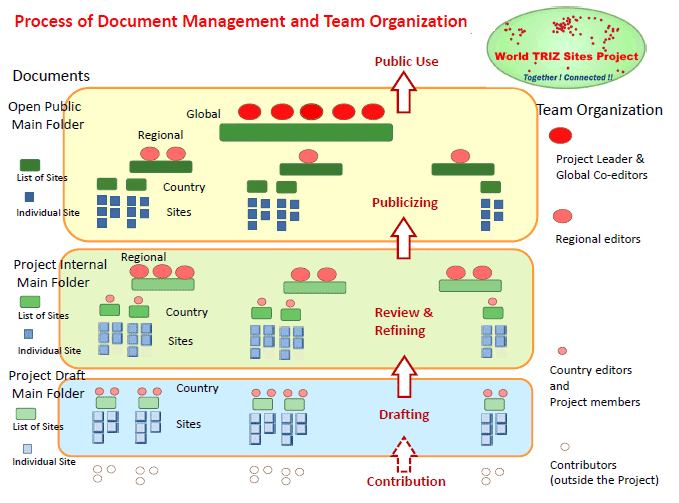
Fig. 3 Organization of WTSP documents and WTSP team.
Descriptions of individual sites may be written by project members or contributed by any people (including site owners) outside the project, and are stored in the Project Draft Main Folder for the purpose of internal revisions. After appropriate brushing up, the site descriptions are edited into a draft Catalog of sites in the country by a small team of WTSP members led by a Country Editor, and are copied into the second stage folder.
In the Project Internal Main Folder, the draft Catalogs of various countries are collected and reviewed and refined by WTSP members of any countries. Regional Catalogs may be an assembly of Country Catalogs, possibly containing selected sites in each country. Refined Regional Catalogs are further integrated into a Global Catalog. Documents in this Main Folder are visible and accessible by all the WTSP members but not visible for non-members.
Then refined documents of the Global Catalog, Regional Catalogs, and Country Catalogs, containing descriptions of individual sites, are copied into the 3rd stage folder, i.e., Open Public Main Folder, for the purpose of publicizing. The decision of publicizing, or copying into the Open Public Main Folder should be made by some of Global Co-editors. Any documents here are viewable and downloadable by any person without charge and without registration.
For the purpose of wider proliferation of the WTSP outputs, whole or parts of the publicized WTSP documents are allowed to be re-posted in various Web sites managed by any WTSP members. It is expected that there occur various cases of necessities of revisions, editing, and translations into different languages. Manuscripts of all these refinements should be fed-back to the WTSP project as the contributions for updating, and should be handled according to the standard documentation procedure described above.
2.4 Organization of the WTSP Project Team.
The WTSP project is a loose organization entirely based on the voluntary involvement by people working in relation to TRIZ and relevant methodologies. Proposals and invitations to WTSP have been sent initially to about 100 TRIZ leaders in the world, but WTSP is open to anybody and any time. Any persons who send the Membership Application Form to the WTSP Project Leader, Toru Nakagawa, are to be accepted as Members.
It is important to form a (small) team of WTSP Members in each country, who work together for describing the TRIZ-related sites in their country one by one and for editing the Country Catalog. Because of different languages used and different situations of activities and communities around TRIZ, the site descriptions and the Country Catalog should be made primarily by the WTSP team of each county, led by the Country Editor (who is assigned on a voluntary basis).
We have set 8 Regions for practical grouping of countries; they are: (A) Europe, (B) Russia and ex-USSR, (C) Mid East, (D) Asia, (E) Oceania, (F) North America, (G) Central and South America, (H) Africa, and (I) Others. Regional Editors may be assigned if appropriate.
Then we have several Global Co-editors, who are cooperatively responsible for decision and direction making for the whole WTSP project in the global scale. Project Leader is one of such Global Co-editors and represents the project.
At the present stage, Toru Nakagawa is the Project Leader, and the six co-authors of the present paper are the Global Co-editors.
2.5 Working Platform and Guidelines of Documentation
In order to handle a large and complex body of WTSP documents by many (several tens or hundreds) voluntary people around the world, we need a groupware system usable in the Internet. So we have chosen the Bitrix24 System in Cloud as our working platform [5]. The system has useful functions, such as documentation system, group communication tools, project/task management, etc. The Standard Cloud Service of Bitrix24 offers us the capacity of 5 Admins, unlimited number of Users, 100 GB online storage for documentation, 10 sites with unlimited number of landing pages, for a reasonable cost (about 100 USD/month). Many video tutorials are offered in the YouTube for explaining the system and its usage.
Then we have set up various guidelines for the WTSP documentation in this platform. They include hierarchical structure of folders/files, naming rules of folders/files, Excel format of describing individual sites, Excel format of Catalog description, etc. At this initial stage, we assumed that all the working documents are stored in the Bitrix24 system in Cloud and every WTSP member accesses the platform and manipulate the documents directly.
Soon we have realized that it is not practical to ask the Members, who are active and busy, for learning the manipulation of the Bitrix24 system newly and handling the documents with unfamiliar new operations. So we changed the documentation format into relaxed text format in MS Word and assumed that the editing work is usually done by each Member/Editor off line using their daily environment and the communication and file transfer are carried out via ordinary emails. The working documents are currently collected at the Project Leader and posted in his Web site “TRIZ Home Page in Japan” [6]. (When the project becomes much more active, the working documents will be uploaded and manipulated in the Bitrix24 platform by some supporting members.)
3 Model of WTSP Catalog of TRIZ-related Sites in Japan
Toru Nakagawa started the work actually to build the WTSP Catalog of TRIZ-related Sites in Japan, first in Japanese and then in English translation. The actual process and the results have been demonstrated closely in his Web site [7, 8].
3.1 Selection of Search Engines and Search Options
He first tried different search engines (Google and Yahoo!) and various search options for finding a search method suitable for our WTSP purpose. Leaving the details of test results and reasoning in the article [7], the final choices of search engine and search options are summarized here:
-
Instead of Google.co.jp, Yahoo!.co.jp was chosen as the search engine. (Note that details of functions and options of these search engines may be different in various countries. Hence you should check them in your own situations. It is reported that Google has much larger share (over 90%) than Yahoo (about 5%) in the world, but Google and Yahoo! have comparable shares in Japan.)
-
The search keyword is simply set as ‘TRIZ’ and a large number (a few hundreds) of output pages are checked. This way seems more effective to make an exhaustive search than making multiple searches with combination of keywords (e.g., ‘TRIZ Innovation’, ‘TRIZ patents’, etc.) and checking smaller number (several tens) of output pages.
-
We want to list up TRIZ-related sites instead of individual TRIZ-related pages. Ordinary searches with Google and Yahoo show the pages (URL), and hence multiple pages are displayed from single sites (or ‘similar pages’ may be suppressed by setting an option). Yahoo.co.jp has the useful option of ‘displaying a link for internal search of the site’; A representative page of each site is shown together with the ‘Hyperlink to command an internal search of the site’. Such hyperlink is useful to quickly check relevant pages (and their number) in each site; e.g., Japan TRIZ Society HP has about 286 pages, while TRIZ Home Page in Japan about 1330 pages.
-
We use the option of ‘Location areas of URL = Japan (or current location as the default)’, in order to search the sites located inside Japan (for building a Country Catalog.). This option seems to be applied surely by Yahoo but loosely or poorly by Google.
-
We use the option of ‘pages in Japanese’ initially, and ‘pages in English’ later.
-
After making a thorough search with the keyword ‘TRIZ’, we have tried to survey more widely with keywords like ‘innovation’, ‘creative problem solving’, ‘idea generation’, etc. for finding relevant sites. Picking up relevant Web sites by use of our general background knowledge is also practical and effective for making our Catalog wider in its scope.
3.2 Describing the Introductions to Individual Sites
Our Catalog is not a simple list of ‘TRIZ-related links’, where each site or page is shown with the name of the site (or title of the page) and its URL. We want to introduce good and useful TRIZ-related sites to various people, such as those unfamiliar, interested in, beginner in learning, practitioner, expert in TRIZ, expert in some other relevant methods, etc. Such introductions should be attractive, understandable, fact-based, concise, correct, fair, non-advertising, etc.
Thus, for describing the introductions to individual sites, we have to visit the sites and read various pages so as to understand the site in the aspect of its nature, background, structure, contents, features, specific topics and articles, quality, etc. The hyperlink of internal search, made by Yahoo, is useful for quickly surveying the pages relevant to ‘TRIZ’ inside the site.
Though a tabular format was initially set for describing the site introductions, more flexible style of description was found preferable. Introduction may be written just briefly (e.g., 1 to 3 lines) for small or less important sites, but more closely (e.g., 3 to 10 lines) for larger and important sites. The articles/pages important and useful in the sites may be mentioned explicitly together with their URLs.
3.3 Different Types of TRIZ-relevant Sites
Various types of sites are found. So the sites are categorized practically in the following types. The number of sites listed in the WTSP Catalog of TRIZ-related sites in Japan [8] are shown in ( ) for each category.
(a) TRIZ-related Information Sending Sites (i.e., important sites having some nature of (b) to (h)) -- (24 sites)
(b) Consultants/Venders/Dealers in TRIZ -- (12 sites)
(c) Academic societies, associations, journals, etc. in TRIZ-related areas -- (17 sites)
(d) Universities, public organizations, not-for-profit organizations, etc. -- (13 sites)
(e) Commercial/non-commercial organizations operating lectures, seminars, distant education, etc. in the TRIZ-related fields -- (3 sites)
(f) Technical dictionaries, book search, technological news, communities, etc. in TRIZ-related areas -- (8 sites)
(g) Personal sites, blog sites, and other non-TRIZ sites which post some TRIZ-related articles -- (14 sites)
(h) Personal sites, blog sites, and other non-TRIZ sites which are useful for TRIZ even though the site do not post TRIZ articles -- (0 sites)
3.4 Manuscripts of the WTSP Catalog of TRIZ-related Sites in Japan
Manuscripts of the WTSP Catalog of TRIZ-related Sites in Japan were made and posted in the Japanese edition (in March 2018) and in the English edition (in April 2018) [8] in THPJ. 92 sites are introduced with close annotation (about 3 to 10 lines) in Japanese. In the English edition, 24 selected sites (of type (a)) are introduced closely while other 68 sites just briefly (about 2 to 3 lines). The selected 24 sites are arranged in a way easy to understand similar approaches and historical evolutions in promoting TRIZ in Japan.
Here shows a small list of 9 selected Web sites with single-line introduction:
-
01 (a) (d) TRIZ Home Page in Japan (Toru Nakagawa): Most active site since 1998 posting TRIZ articles and papers internationally.
-
03 (a) (c) Japan TRIZ Society (NPO): Nation-wide center for promoting TRIZ, organizing Japan TRIZ Symposium every year.
-
09 (a) (b) IDEA Corp. (Mamoru Zenko): Active consulting firm promoting integral use of QFD-TRIZ-TM and Goldfire software.
-
10 (a) (b) MOST (Kazuya Yamaguchi): Consulting firm promoting integral use of QFD-TRIZ-TM and AI (big data analysis).
-
12 (a) (b) Ideation Japan, Inc. (Teruyuki Kamimura): Actively promoting Ideation-TRIZ, strong in IP field.
-
14 (a) (g) TRIZ Study (Shinsuke Kurosawa): Posting many papers by G. Altshuller and other Russian authors in Japanese translation.
-
16 (a) (b) Pro-Engineers (Shigeru Kasuya): An active consultant promoting TRIZ/USIT, posting many introductory articles.
-
17 (a) (b) IdeaPlant (Rikie Ishii): Conducting workshops for enhancing idea generation; has developed 'TRIZ Brainstorming Cards'.
-
18 (a) (e) Monodukuri.com (Osamu Kumasaka): Active portal site connecting Issues in monodukuri (60 issues) to Methods for solutions (118 methods) by getting support of many professionals. This is a nice new business model.
In the Appendix, introductions to these 9 sites are shaow as samples of WTSP site description [8]. You may learn various unique activities in TRIZ in Japan.
3.5 TRIZ-related Sites and WTSP Team in Japan
As mentioned above, our WTSP Catalog introduces 92 TRIZ-related sites, and 24 of them are selected as important useful sites in Japan. Contents of these sites have been improved much in the volume, scope, and quality from those in the 100 sites listed in 2008 [1]. It is also remarkable that about 2/3 of the present 92 sites have emerged after 2008. Almost all the TRIZ sites in Japan are written in Japanese only. Exceptions are Nakagawa’s TRIZ Home Page in Japan and (a part of) Japan TRIZ Society’s HP written in English as well as in Japanese. A significant number of engineers who promoted and applied TRIZ in industries have started training/consulting firms after (or sometimes before) their official retirement of industries. TRIZ teaching and application activities in universities are not growing much mostly because of the generation change in academic TRIZ leaders.
Information and invitations of WTSP have been sent to about 30 TRIZ leaders in Japan, and update announcements of TRIZ Home Page in Japan, containing information of WTSP, have been regularly sent to a few hundred readers of THPJ in Japan. Supportive messages have been received from some of them. But nobody have joined the WTSP project yet, unfortunately.
4. WTSP Activities in the World
At the end of April 2018, Nakagawa sent WTSP Letter to about 100 TRIZ leaders in the world for asking their cooperation in the WTSP project [9]. Our project has just finished its preparation stage successfully, setting policies, platforms, and guidelines and demonstrating the WTSP Catalog in Japan as a model. And we are at the stage of starting the actual work for building WTSP Catalogs in individual countries and in the world. Frankly speaking, however, our WTSP project is still very small and weak. Thus we sent late June WTSP Appeal [10] in the names of the six coauthors of the present paper, as WTSP Global Co-editors. The Appeal is posted in several Web sites including LinkedIn, for wider circulation.
4.1 Current WTSP Members and Leaders
At the stage of May 31, 2018, our WTSP project has 19 Members who voluntarily joined from UK, Netherlands, Germany, Italy, Poland, Portugal, Russia, Palestine, Japan, Korea, China, Malaysia, Thailand, Australia, USA, and Brazil. Among them, we have 3 Country Editors, i.e., Toru Nakagawa (Japan), Tan Runhua (China), and Sylvio Sylveira Santos (Brazil), and 6 Global Co-editors who jointly present this paper as the co-authors.
The WTSP Team at moment is very small and weak. For building our WTSP Catalogs smoothly, as demonstrated in Japan, we will need at least 100 Members, we guess. The reasons for difficulty are clear: active and talented people are always very busy to do their jobs. Even though they support the vision of WTSP, they think they cannot spend their time to get involved in such a voluntary job beside their own business. The solution direction is to divide the whole WTSP task into clear-cut smaller tasks and for many colleagues to work cooperatively to achieve the small tasks in parallel, and also to find some talented people with passion for achieving the WTSP goals spending time even in their busy schedules.
4.2 Base and Working Documents of the WTSP Catalogs
As the base document for our WTSP project, Nakagawa’s article ‘Extended 120 TRIZ Links in the World’ [1] is used. It is useful to see the overall view of TRIZ related sites in the world 10 years ago. Probably about half of the sites listed are still active and enhanced (while the other half are lost or inactive), and probably over 200 new sites have emerged in these 10 years. Thus the base documents should be completely revised and updated in our project
Contributions and manuscripts of descriptions of individual sites are currently gathered at the Project Leader, and they are combined into the current working documents and posted in THPJ [6]. Manuscripts are written and edited with MS Word and are sent via email, for easy and daily handling.
Activities of updating and the working documents are regularly uploaded in THPJ [6]. Except the work in Japan, the updating activities are rather few so far. The following number of sites are updated for these 2 months: 14 sites in Europe, 2 sites in Russia, 5 sites in Asia, 2 sites in N. America, 1 site in C. & S. America. Descriptions of the sites are mostly only brief. Thus, the WTSP activities are not yet starting well.
4.3 Current Tasks for Building WTSP Catalogs in Each Country
In these situations, we are asking TRIZ leaders/colleagues in the world for their help as follows [9, 10]:
(1) Please join the WTSP project for the voluntary cooperative work of building WTSP Catalogs in each country and in the whole world.
(2) It is most important to form a WTSP team (of several Members) in each country. Only the people of your own country are possible and also responsible for building the WTSP Catalog of TRIZ-related Sites in your own country. Besides the language ability, it is often necessary to have background knowledge of the society, culture, TRIZ community, history of TRIZ promotion, etc. in your country. Assigning (or volunteering) a Member as the Country Editor is of practical importance to achieve the goals.
(3) Search for TRIZ-related sites, and visit and investigate the sites to describe the introduction to the sites one by one. Descriptions of individual sites are important. We should note that such descriptions (or even just listing a site) naturally reflect the writer’s evaluation of the sites. Our WTSP project can get appreciation only when our Catalogs are fair and attractive in the selection and descriptions of the sites. Samples of site descriptions are shown in the Appendix. The WTSP Catalogs should be made in the country’s own language; such an edition in your own language is useful for many people in your country.
(4) Then the Catalogs should be translated into English to be integrated into the Regional Catalog and finally into the Global Catalog. In this process, good and useful sites should be selected to reduce the number of sites in the higher-level Catalogs.
4.4 Tasks for Building the WTSP Catalogs of the World
(5) The next step is to integrate all the WTSP Catalogs of individual countries into the WTSP Catalogs of the World. We may need various editorial work here, to fill up the missing parts/countries, to refine some parts in particular, to make various descriptions as much as consistent, etc. The editorial work at this stage may be difficult because such editors may not have visited some sites especially posted in non-English languages.
(6) Another task at this stage is to build up the WTSP Catalogs of TRIZ-related Sites especially grouped in the categories of their fields/approaches/methodologies etc. How to categorize and represents the sites will need further investigation.
(7) Completed WTSP Catalogs of the World and of various individual countries are to be posted publicly. They may be accessed and downloaded by any people. The whole or some parts of the Catalogs may be re-posted in Web sites of any WTSP Members for the purpose of wider sharing of the results. In such cases, there may be needs to translate the WTSP World Catalogs into different national languages. Such translation work should be carried out by the WTSP teams in individual countries.
5 Concluding Remarks: Further Visions
5.1 Applying TRIZ to WTSP: IFR for WTSP
It is perhaps one of the responsibilities of members of the TRIZ community to apply the principles of TRIZ to the evolution of TRIZ. Some outsiders to the subject would say that this has not happened to any great extent in the last two decades. The WTSP committee is keen to right this problem.
One of the key tenets of TRIZ is that all systems evolve towards an Ideal Final Result end point, which delivers all of the desired benefits with zero cost or harm. What this ultimately means is that the ideal TRIZ knowledge database organizes ‘itself’:
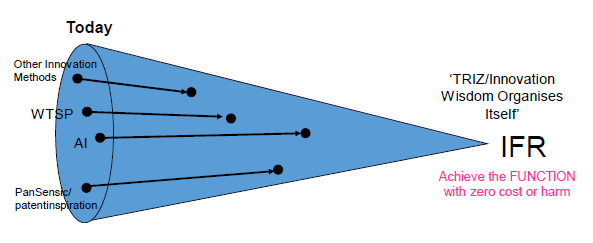
Fig. 4 Evolution of TRIZ Knowledge towards Ideal Final Result
This word ‘self’ is always an important one when thinking about ideal solutions. Not least because every member of the TRIZ community is busy and thus has very limited time to devote to organizing the TRIZ literature of their country, or the world. The WTSP is actively working towards the creation of such self-organising solutions.
Another key tenet of TRIZ is the importance of Function. This tenet says that customers want the function and not a particular solution. At the highest level, this means that no-one ‘wants’ TRIZ, but rather they are looking to help understand an innovation situation, or wish to solve a difficult problem, or create stronger IP. With this in mind, it is inevitable – and also hinted at in Figure 4 – that TRIZ will be integrated with other innovation-relevant tools and methodologies.
That integration may well be some time in the future, but what we know it tells us already today is that ‘someone, somewhere already solved our problem’. And what that means is that the TRIZ community is not the only community in the world with a desire to organize all of the content that is being generated. In this sense, tools like PanSensic [11] and patentinspiration [12] – both built on TRIZ principles – are already able to do a significant part of the knowledge organization job. Whether it is one or both of those solutions that will eventually prevail, one thing is certain in the longer term and that is that Artificial Intelligence algorithms will be harnessed to ‘automatically’ conduct the knowledge organization job. Very likely ‘on the fly’- creating up to date context-relevant knowledge to users upon demand.
5.2 Applying TRIZ to WTSP: Contradictions in WTSP Tasks
This inevitable future capability, however, brings to mind another tenet of TRIZ that is pertinent to the WTSP task. As everyone in the TRIZ community knows, innovation is largely about the emergence and resolution of contradictions. The evolution of the WTSP database is, of course, also subject to the rules of the evolutionary S-curve. It is our job to identify and then actively work to solve such contradictions. At this point in time in the evolution of the WTSP story, the Committee is actively working on two such contradictions:
(1) Once knowledge repositories become large, they become increasingly difficult and time-consuming for users to search. One of the growing challenges is that some pieces of knowledge are more accurate and of higher quality than others. This has long been a contentious issue in the TRIZ community at large, with disputes and arguments between different authors frequently being exposed to the public at large. While this kind of argument is typical of any scientific discipline, it is rarely useful to expose it to newcomers to a subject, especially in these days of near infinite content in the more-general ‘innovation’ domain that sits around TRIZ. One resolution to the quantity-versus-quality conflict is the general recognition that sooner or later, ‘the cream always rises’. The only challenge with this is that the rate of rise is usually much slower than customer needs evolve. Asking people to rate articles and papers offers up some assistance, but as the world is already seeing in situations where feedback loops have become near ubiquitous (Trip Advisor, Amazon Reviews, etc), that the large majority of people giving feedback are either poorly qualified to do so, or operate under the general internet protocol, ‘play nice’. Which ultimately means that everything eventually tends towards receipt of four star review status and the whole purpose of assessment by quality becomes corrupted. The same is also true, albeit slower in the academic world [13]. Far stronger solutions from the AI world on the way. They also help to solve the second problem:
(2) Context. A given piece of TRIZ content, irrespective of its quality, will only be deemed ‘useful’ to a reader provided that it is deemed to be relevant to the specific context of that reader. As a designer, for example, looking for some help to deploy TRIZ on a very specific and highly constrained pharmaceutical contradiction challenge, does not want to have to sort through thousands of non-pharmaceutical-related contradictions (even though – we know – TRIZ is very often about making bridges between one domain and another!) before finding something useful. Neither do they wish to search through multiple different local or nation-oriented sub-databases. Again thinking about IFR solutions, as a user of WTSP, we are first likely to want to find relevant information within our own domain, quite likely – depending on the context of our challenge – then we’d like to look at the ‘adjacent possible’. Solutions from outside our domain that will turn out to be relevant to our situation. Still others might wish to search even more broadly and gain some relevant inspiration from a very different but still nevertheless ultimately fulfilling domain. There are no right or wrong answers here because every user of WTSP (or any other knowledge database for that matter) has a context-driven need that potentially changes from one day to the next. Which is ultimately why, WTSP (and other domains) will evolve to ‘self-organising’ solutions. The WTSP committee is cognizant of the need and – again through things like PanSensic and patentinspiration – is building solutions that will eventually do much of the ‘heavy-lifting’ desired by users.
5.3 Vision of Global Network of Public Web Sites in TRIZ
Cooperative relationships among important TRIZ Web sites in the world can be envisioned more clearly in the proposal of ‘Global Network of Public Web Sites in TRIZ’ [2]. The vision is illustrated in Figure 5. Here ‘Public Web site’ means Web sites serving as information hubs and document repositories, which openly accept contributions by many authors and openly publish them to the public under the operation by some editor(s) having some fair policy. It is much desirable to translate important articles in bidirectional ways for overcoming language barriers (using English as the default standard). This is the vision of cooperative information exchange of articles among Web sites in the world, and is some steps ahead of the present WTSP Catalogs which serve for cooperative exchange of information of sites at the introduction level. Such ‘Global Network of Public Web Sites’ can grow and work autonomously without any control center and help to build a cooperative Global Community in TRIZ
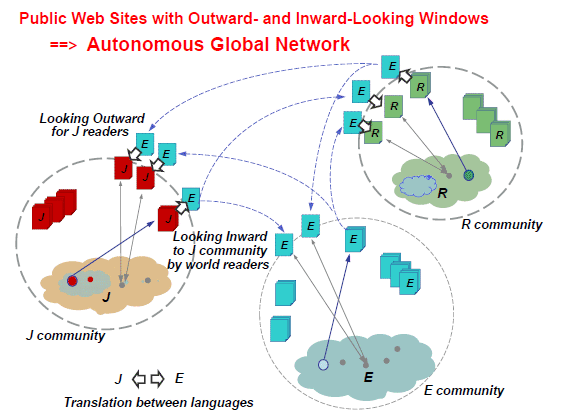
Fig. 5 Proposal of Global Network of Public Web sites [2]
5.4 Let’s Work Together ! Connected !!
Those are some future visions, however. Right now, the need is to start the ball rolling. And with that in mind the first generation WTSP Catalogs of TRIZ-related Sites will show all the important Web sites related to TRIZ in a wider scope at a glance. Since they are built and publicized by the cooperative work of many TRIZ leaders in the world, they serve as rich and reliable information source of TRIZ-related Web sites and of TRIZ-related articles and activities in the world. Thus the WTSP Catalogs are much more useful and effective than ordinary internet surveys for many people in the world, both inside and outside the TRIZ Community.
For building such WTSP Catalogs -- Let’s work Together ! Connected !!
References
[1] Nakagawa, T., Extended 120 TRIZ Links in the World, THPJ, http://www.osaka-gu.ac.jp/php/nakagawa/TRIZ/eTRIZ/elinksref/eWorldLinks.html  , posted 2008/5/4
, posted 2008/5/4
[2] Nakagawa, T., Global Network of Public Web Sites in TRIZ: A Proposal for Building A Global TRIZ Community, THPJ, http://www.osaka-gu.ac.jp/php/nakagawa/TRIZ/eTRIZ/ eforum/e2008Forum/ePublicSites08/ePublicSitesProposal080525.html  , posted 2008/5/24
, posted 2008/5/24
[3] Nakagawa,T., World TRIZ Sites Project: Its Plan and Invitation -- Volunteer Project for Connecting TRIZ Sites in the World, THPJ, http://www.osaka-gu.ac.jp/php/nakagawa/TRIZ/eTRIZ/eforum/e2017Forum/eNaka-WorldTRIZSitesProject2017/eNaka-WTSP-Invitation-171207.html  , posted 2017/12/9
, posted 2017/12/9
[4] Nakagawa T., World TRIZ Sites Project (WTSP), http://www.osaka-gu.ac.jp/php/nakagawa/TRIZ/eTRIZ/eWTSP/eWTSP-index.html  , posted 2017/12/27
, posted 2017/12/27
[5] WTSP project platform in the Bitrix24 system, https://TRIZSites.bitrix24.com/ 
[6] Publicized Outputs of WTSP (World TRIZ Sites Project),, THPJ, http://www.osaka-gu.ac.jp/php/nakagawa/TRIZ/eTRIZ/eWTSP/eWTSP-Outputs.html  , posted 2017/12/27.
, posted 2017/12/27.
[7] Nakagawa T., Starting the preparation of 'A Catalogue of TRIZ-related Sites in the World' (1) Findings through Practices in Japan, (2) For more practical ways of preparation, THPJ, http://www.osaka-gu.ac.jp/php/nakagawa/TRIZ/eTRIZ/eWTSP/eWTSP-B2-News2018/eWTSP-News2018-Trial-Japan1-180127.html  , posted 2018/1/30, 2018/2/7
, posted 2018/1/30, 2018/2/7
[8] Nakagawa T., Catalog of TRIZ-related Sites in Japan, THPJ, http://www.osaka-gu.ac.jp/php/nakagawa/TRIZ/eTRIZ/eWTSP/eWTSP-Outputs/eWTSP-D-jp-Japan/eWTSP-D-jp-Japan.html  , posted 2018/4/24
, posted 2018/4/24
[9] Nakagawa T., WTSP Letter: For Forming WTSP Teams to Build WTSP Catalog in Each Country, THPJ, http://www.osaka-gu.ac.jp/php/nakagawa/TRIZ/eTRIZ/eWTSP/eWTSP-B2-News2018/eWTSP-News2018-Letter-180517.html  , posted 2018/5/19
, posted 2018/5/19
[10] Nakagawa T., Mann D., Orloff M., Dewulf S., Litvin S., Souchkov V., WTSP Appeal: An Appeal for Building Catalogs of TRIZ-related Sites in the World, THPJ, http://www.osaka-gu.ac.jp/php/nakagawa/TRIZ/eTRIZ/eWTSP/eWTSP-B2-News2018/eWTSP-News2018-Appeal-180625.html  , posted 2018/6/25
, posted 2018/6/25
[11] Mann D., Systematic Innovation | PanSensic, http://www.systematic-innovation.com/pansensic.html 
[12] Dewulf S., Search and Analize Patents - patentinspiration http://www.patentinspiration. com/ 
[13] Mann, D.L., ‘Case Study: Perverse Incentives In Academia’, Systematic Innovation E-Zine, Issue 185, August 2017.
Appendix: Selected 9 Sites in the WTSP Japan Catalog [8]
01 (a) (d) TRIZ Home Page in Japan http://www.osaka-gu.ac.jp/ php/nakagawa/TRIZ/  (in Japanese), http://www.osaka-gu.ac.jp/php/nakagawa/ TRIZ/eTRIZ/
(in Japanese), http://www.osaka-gu.ac.jp/php/nakagawa/ TRIZ/eTRIZ/  (in English)
(in English)
Editor: Toru Nakagawa (Professor (1998-2012)/Professor Emeritus (2012- ) of Osaka Gakuin University). He established this site in Nov. 1998 (Nov. 1 in Japanese and Nov. 15 in English), and has been posting new TRIZ-related information actively with unfixed interval of 2 to 4 weeks constantly till present.
The site posts introductory articles, overviews, papers, conference reports, etc. on TRIZ with a wider scope. Pages in Japanese and pages in English are posted more or less in parallel. The articles/papers are written not only by the Editor (in Japanese and in English), but also by many Japanese authors (in Japanese and some in English translation) and by many overseas authors (in Japanese translation and some in English). It has four 'Entrance Pages' adapted for four types of readers (i.e., for Children and high school students, for Students and the general public, for Engineers and researchers novice to TRIZ, and for Practitioners and experts of TRIZ); they show categorized lists of (pretty many) recommended pages with annotation.
The Editor's research themes have evolved from (a) introduction and proliferation of (classical and modernized) TRIZ, to (b) introduction and extension of USIT (Unified Structured Inventive Thinking), (c) proposal of Generalized Methodology for Creative Problem Solving (CrePS), and (d) Research on the Principal Contradiction ('Liberty vs. Love') of Human Culture.
03 (a) (c) Japan TRIZ Society (NPO) http://www.triz-japan.org/  (in Japanese)
(in Japanese)
http://www.triz-japan.org/english_top.html  (in English)
(in English)
Japan TRIZ Society is the nation-wide Center for promoting and proliferating TRIZ in Japan, established officially in December 2007 on the basis of Japan TRIZ CB.
It has organized TRIZ Symposium in Japan every year (from the Fourth in 2008 to the Thirteenth in 2017). The Symposium till 2012 was held for 3 days with actively calling for participation/presentation by overseas people, but later since 2013 it was held for 2 days and with mostly-domestic participation/presentation except invited Keynote speakers from abroad. Every year many user industries gave their presentations on TRIZ usage and promotion. (Almost) all the presentations were shown with slides in Japanese and in English in parallel. Keynote Lectures and Award-winning presentations (about 5 papers every year, voted by the participants) are publicly posted in the Web site about 3 months later, and all other presentations are posted in the 'Members only' pages of the site.
The short TRIZ introduction article in this HP is rather poor unfortunately, I think. In Japan TRIZ Society, four study groups are running for several years.
09 (a) (b) IDEA Corp. http://www.idea-triz.com/  (in Japanese)
(in Japanese)
IDEA is a consulting firm specialized in TRIZ, starting in 2003 by spinning off from ITEQ, and has been actively conducting trainings and consulting in industries and open seminars. IDEA has particular strength in applying QFD-TRIZ-TM in an integrated manner to new product development, and in consulting with big and SME companies in such a strategy.
The Web site explains to use the following four IDEA-style scientific development methods in an integrated way: Seeds-driven Quality Deployment (SDCD, for developing new business fields), IDEA-QFD (for developing new products in existing business fields), IDEA-TRIZ (for innovative problem solving with break-through solutions), and IDEA-TM (for implementing new solutions optimally). Various documents of these TRIZ-related methods are downloadable free of charge (with registration). IDEA also sells TechOptimizer and Goldfire Innovator of Invention Machine (later under IHS) as a dealer and promotes the use of software tools together with their methods.
At Japan TRIZ Symposia, several industrial customer companies reported their successful results of promoting/applying IDEA ways in their new product development, confirming the effectiveness of IDEA’s methods and consulting.
The following two blog sites were operated several years ago, but have not been updated recently:
Blog by Mamoru Zenko, President: ' I'm fine, today, too' (Diary by IDEA President): http://blog.livedoor.jp/n2ublog-00018/
Blog by Masahiro Kuwahara, Senior consultant: ‘Daily inventive monolog by a TRIZ consultant’: http://kuwatriz.exblog.jp/
10 (a) (b) MOST LLC www7b.biglobe.ne.jp/~most/  (in Japanese)
(in Japanese)
Since 2001 Kazuya Yamaguchi led the innovation of development process and quality management in Kyushu Matsushita Electric Co. (renamed into Panasonic Communications Co. (PCC) in 2003) by using scientific methods including quality engineering, TRIZ, and QFD. He retired from PCC in 2007 and started a consulting firm, MOST LLC, together with his several colleagues who worked together for the PCC process innovation.
MOST's philosophy is “To propose and provide methods for drastic innovation applicable in the era of AI (Artificial Intelligence, e.g., IoT and Factory big data)”. More specifically it proposes "to use scientific technology tools in the world (e.g., QFD, TRIZ, Quality engineering (or TM), MATLAB, and some other universal-use tools) effectively, to improve the current styles of research, development, design, and manufacturing into new business promotion styles with high efficiency, and to put your business on a sustainable and growing curve by obtaining maximal results in achievements."
Their methods are written closely by the MOST members in their books (or white papers), which are available in their HP with free downloading (without registration). They include:
(1) "Improve your quality, then your costs get reduced (recommendations to Taguchi Method)" by Kazuya Yamaguchi (95 pages).
(2) "How to eliminate the needs of remaking software in the market due to bugs (recommendations to Taguchi Method)" by Kazuya Yamaguchi (27 pages).
** snip **
(8) "Business strategy for executives to raise their performance surely (Raising performance/results come from raising members)" by Kazuya Yamaguchi (31 pages).
All these textbooks are impressive with their strong encouraging messages.
12 (a) (b) Ideation Japan, Inc. https://ideation.jp/  (in Japanese)
(in Japanese)
Ideation Japan was raised by Teruyuki Kamimura, a patent attorney, in 2010 and currently is the only agency of International Ideation Inc. (USA) in Japan.
In Ideation International, TRIZ Masters (and collaborators of G. Altshuller since 1970s) Boris Zlotin, Alla Zusman, et al. developed TRIZ further in depth to form a new and big system named Ideation-TRIZ (or I-TRIZ). The system is composed of 3 main components, i.e., Inventive Problem Solving (IPS), Anticipatory Failure Determination (AFD), and Directed Evolution (DE). Such methods are supported by software tools which install well-systematized solution prototypes (called System Operators).
The HP of Ideation Japan posts many introductory articles on these methods in a way easy to understand. Multiple issues of pamphlets are downloadable (free of charge, with registration), and videos of an introductory seminar (14 parts, over 3 hours in total) can be seen free of charge (without registration). Ideation Japan conducts seminars on I-TRIZ and its software tools pretty frequently (with or without charge) as a part of its active proliferation activities.
In 2013 it established 'I-TRIZ Promotion Association' for the purpose of promoting their private I-TRIZ certification.
14 (a) (g) TRIZ Study (Shinsuke Kurosawa) http://www.trizstudy.com/  (in Japanese) http://www.trizstudy.com/contentslist.html
(in Japanese) http://www.trizstudy.com/contentslist.html  (in English, List of Contents in their original languages)
(in English, List of Contents in their original languages)
This site intends to be a Web site for the people who want to study TRIZ deeply in the Japanese language. The site owner is Shinsuke Kurosawa, formerly at SANNO Institute of Management. He is very fluent in Russian and has been working to study and proliferate TRIZ since mid-1990s.
This site is of special importance in Japan in the points that many original TRIZ papers written by G. Altshuller are posted in Japanese directly translated from Russian. He also posts Japanese translation of various documents authorized by MATRIZ (i.e., International TRIZ Association), e.g., TRIZ Textbook for MATRIZ Level 1 certification, TRIZ Body of Knowledge (BOK), etc. Besides them he introduces a number of papers on modern TRIZ in Russia, especially those related to education with TRIZ.
A wonderful article in this site for introduction to TRIZ is the instructions and worksheets of "16 steps in TRIZ for you to use today (for solving your problems)", which he has originally written down concisely. As the process for solving problems, he shows the sequential points of focus in 6 main steps (i.e., problem/task/ideality, situations/viewpoints, inventive principles, resources, strategies/contradictions, and action plan) having 16 sub-steps in total. For each sub-step, he shows in a worksheet the questions to think, and in the text in parallel he describes the instructions, simple examples, and a consistent set of case study. The process is so simple and yet powerful that engineers novice to TRIZ may be able to work with it for him/herself even today.
16 (a) (b) Pro-Engineers (Shigeru Kasuya) http://www.proengineer-institute.com/  (in Japanese)
(in Japanese)
Shigeru Kasuya worked for SONY and later for Fuji Xerox, and started his consulting firm 'Pro-Engineer' in 2006. His site states its purpose as "TRIZ & Support for Differentiating Technology Development". He intends to support not only the usage of TRIZ but also more widely the development of new technologies/products, innovation in business processes, human resource development of researchers and engineers, etc.
The top page of his Web site is a tightly packed index to a lot of information in the site. There are interesting articles such as abstract documents of his various seminars, articles in newspapers and journals mentioning about his work, his answers to questions/issues raised by various industry users (over 40 articles, which are posted also in the Q&A corner of Monodukuri.com,). He also shows his own examples for 40 Inventive principles; they include illustrated examples for all the 104 sub-principles, examples from the areas of IT/SW, chemistry, and biology.
Contradiction Matrix (in the classical form) is also installed in the HP so that the inputs of an improving parameter and a worsening parameter return the outputs of four inventive principles. He writes an interesting suggestion that a simple Google search with a keyword of target object and a second keyword of function/property can give the information very similar to the results from TRIZ Effects database. At the end of the site, several case studies of solving problems with TRIZ are demonstrated. This is an interesting site giving us a lot of new suggestions.
17 (a) (b) IdeaPlant (Rikie Ishii)https://ideaplant.jp/  (in Japanese),
(in Japanese),
Rikie Ishii's Activity Report http://ishiirikie.jpn.org/  (in Japanese) ,
(in Japanese) ,
https://ideaplant.jp/triz/index.html  (in English) (only partly)
(in English) (only partly)
IdeaPlant was a name of a group organized by Rikie Ishii in 2005 in Sendai, with the intention of 'a place for growing seeds of ideas into large trees'. (The group seems to have worked in the name of 'Miyagi TRIZ Study Group' for a certain time.) Ishii made the IdeaPlant as a business in 2009.
He has been working energetically for raising creative persons and creative organizations, mostly by devising/practicing/proliferating the methods/processes/tools for enhancing the idea generation. He has produced 'TRIZ Brainstorming Cards' (i.e., playing cards with simplified phrases and illustrations of TRIZ 40 Principles), 'BreStir' (i.e., a playing process for enjoying and activating the Brain Storming using some specialized cards), among others.
He conducts many 'Workshops for enhancing idea generation' at various industries, universities, high schools, local communities, etc., getting high reputation on his vivid way of workshops. His activities at various places in Japan (and some in neighboring countries) are reported frequently in his blog "Activity Reports by Rikie Ishii". He also actively uses various IT media such as Facebook, Twitter, YouTube, SlideShare, etc. We can learn his way of workshops and idea generation through his presentation slides, "Techniques for creative idea generation" at his 5-hour mini-lecture and workshop held in Kyoto in February 2018. https://www.slideshare.net/ishiirikie/5-88358296 . His presentation is always attractive with his illustrations and good design sense.
18 (a) (e) Monodukuri.com https://www.monodukuri.com/  (in Japanese)
(in Japanese)
This is a nice portal site which has produced and implemented a mechanism for connecting (a) Issues in monodukuri (or manufacturing in general) (and the industries having them) with (b) Methods useful for solving the issues (and the professionals in such methods). The basis of this mechanism is the 'Monodukuri Engineering Matrix' which Osamu Kumasaka built during his R&D work for Pioneer Corp. The Matrix has rows of 60 Issues for monodukuri (i.e., Planning 7, Development & design 15, Manufacturing 22, and Quality in market 6) and columns of 118 Methods for solutions (including Strategy techniques 9, TRIZ 8, USIT 1, Quality engineering 8, etc.). In the Matrix cells, applicability and usefulness of the method for the issue is shown with the 4-grade evaluation (i.e., 3, 2, 1, and 0).
Kumasaka started this Monodukuri.com site in 2012 after his retirement. First he obtained supports and registrations by many professionals (currently 138), and obtained their contributions of introductory articles on individual methods and their usage (currently 1600 articles, 2-3 pages each), training texts (currently 490 documents), and application case studies (currently 950 cases), for publicly posting in the site. Users (in industries) may choose an issue most relevant to his/her problem from the list of 60 Issues, then is led by the Matrix to possibly applicable/useful methods, and can further study the methods closely by reading their introductions and case studies. If a user asks a question (or raise his/her own issue) openly at the site, any professionals may reply to it openly at the site as well.
All these basic use of the site is free of charge for the users (some of them need registration without charge), while there are additional services of seminars and individual consultation with charge. The site is now operated with annual support money and payback for consulting arrangement from the registered professionals. Professionals seem to find merits in the site for paying such money. Recently, the site started a service by professionals to support SMEs for their applications to governmental grants.
Because of the accumulation of useful information and appropriate operation mechanism, this portal site is now growing steadily year after year. This is certainly a significant business model started by Osamu Kumasaka.
Last updated on Nov. 11, 2018. Access point: Editor: nakagawa@ogu.ac.jp





























